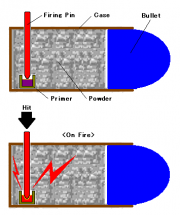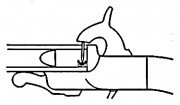Pinfire
Contents |
History
After his death in 1852, his son Eugene continued to market the design with great success. It quickly became popular in Continental Europe and large numbers of revolvers (often called Lefaucheux pistols, after French inventor Casimir Lefaucheux) and shotguns were manufactured from the 1850s until the 1880s. They were quicker and easier to load than percussion weapons with loose black powder, percussion caps and bullet; and they were also much more likely to fire when wet. Numerous calibres were produced, ranging from 5 mm to 15 mm or more.
The revolvers in particular became widespread, being adopted by the armies of France, Italy, Spain, Switzerland, Sweden and others. They were also used during the American Civil War, although sometimes despised because of their low power compared to Colt and other percussion revolvers. Some navies also adopted them, "sea service" examples often being made out of bronze which is largely unaffected by the corrosion caused by salt.
Pinfire became obsolete once reliable rimfire and centre fire cartridges became available because without a pin which needed aligning in the slot in the chamber wall they were quicker to load. They were also safer because they had no protruding pin which could cause the ammunition to accidentally detonate during rough handling, particularly of loose ammunition.
The pinfire concept was also only really suitable for single-shot or multiple-barrelled firearms and revolvers as the pin would have complicated any mechanism for feeding from a magazine. Nevertheless the last practical pinfire revolvers were manufactured around 1890, but by then they were an anachronism.
Current Status
Some modern novelty miniature guns are manufactured in very tiny calibres, such as 2 mm. Although not practical weapons, they use pinfire ammunition because the calibre is too small for centre fire or rimfire. Antique pinfire firearms are available, as well as specialized cartridges which can be handloaded, though the process is far more complex than for centerfire cartridges.[1]
Images
A 16 gauge shotgun shell, pinfire.
A pinfire shotgun shell in a 16 gauge shotgun. Note how the firing pin extends beyond the outer wall of the barrel.
See also
- List of handgun cartridges
- File:Pinfire vs rimfirfe.PNG, for an illustrated comparison of pinfire/rimfire workings.
References
- ↑ "To Shoot My Pinfire" by Darrel G Dennis in Bob Bell, ed (1997). "Handloader's Digest" (17th ed.). Iola, WI: DBI Books. pp. 194,195. ISBN 0-87349-192-0.





